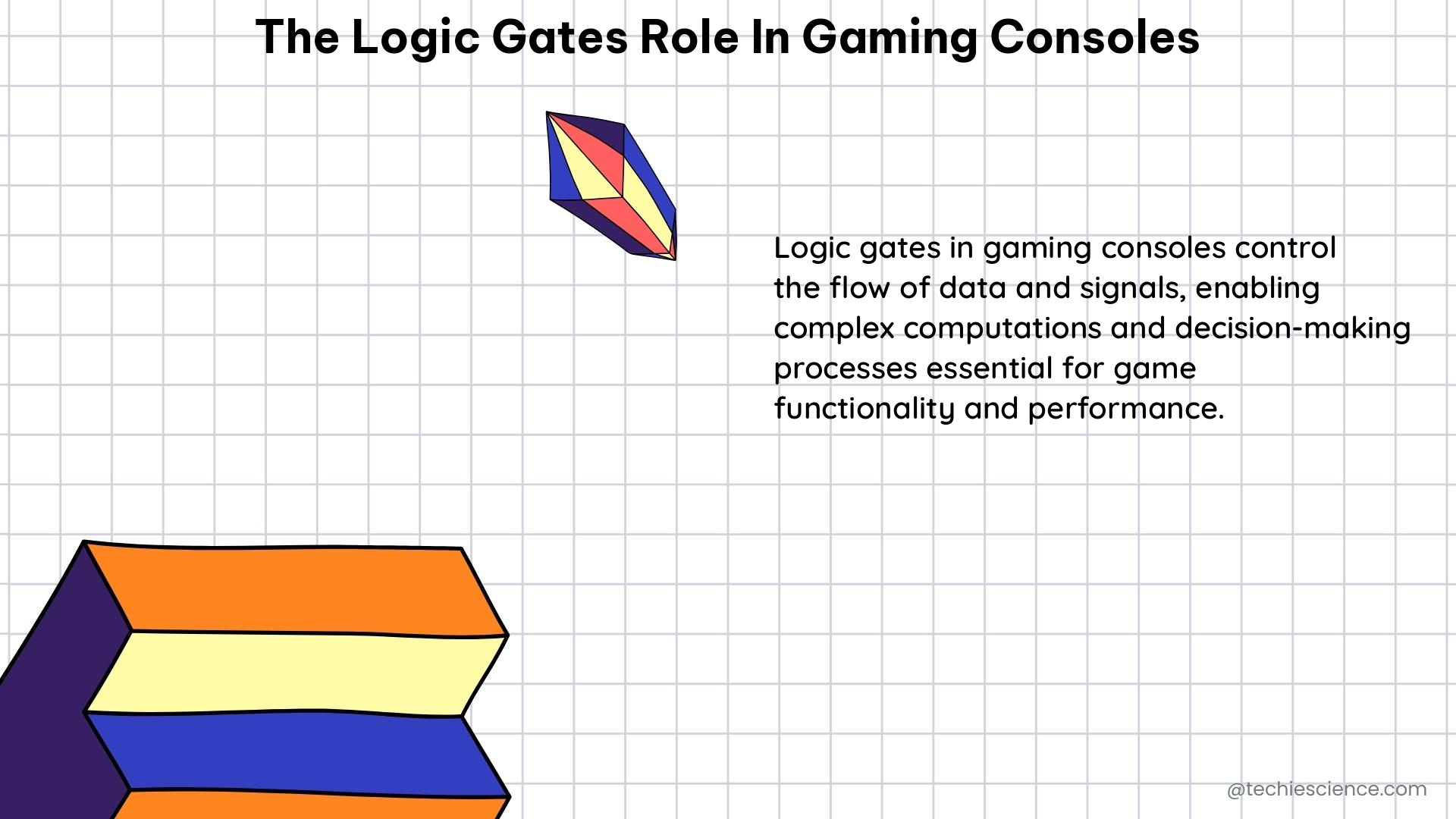The logic gates play a crucial role in the functioning of gaming consoles by processing and manipulating digital signals, enabling the performance of complex tasks. These fundamental building blocks of digital electronics are essential for creating the intricate digital circuits that power the advanced features and capabilities of modern gaming consoles.
Understanding Logic Gates
Logic gates are the basic components that form the foundation of digital electronics. There are seven primary types of logic gates, each with its unique symbol and truth table:
- AND Gate: Outputs a high signal (1) only when all inputs are high (1).
- OR Gate: Outputs a high signal (1) when one or more inputs are high (1).
- NOT Gate: Inverts the input signal, outputting a high signal (1) when the input is low (0), and vice versa.
- NAND Gate: Outputs a low signal (0) only when all inputs are high (1).
- NOR Gate: Outputs a low signal (0) when one or more inputs are high (1).
- XOR Gate: Outputs a high signal (1) when the inputs are different (one high, one low).
- XNOR Gate: Outputs a high signal (1) when the inputs are the same (both high or both low).
Logic Gates in Gaming Consoles

In the context of gaming consoles, logic gates are used to create digital circuits that perform specific functions. These circuits are responsible for processing and manipulating the digital signals that control various aspects of the gaming console’s operation.
Adder Circuits
One of the most common applications of logic gates in gaming consoles is the design of adder circuits. These circuits are used to compute the sum of two binary numbers, a fundamental operation in many gaming-related calculations. By using a combination of AND, OR, and XOR gates, engineers can create efficient adder circuits that can perform complex mathematical operations with high speed and accuracy.
Seven-Segment Display Circuits
Another example of the use of logic gates in gaming consoles is the design of circuits for seven-segment displays. These displays are commonly used to show numerical information, such as scores, timers, or other game-related data. By using a combination of logic gates, engineers can create circuits that can control the individual segments of the display, allowing for the dynamic display of information.
Logic Systems in Games
Beyond the hardware-level applications, logic gates can also be used to create logic systems within games themselves. For instance, in the game Satisfactory, players can use logic gates to create complex systems for data collection, automation, and other dynamic features. By understanding the principles of logic gates, game developers can create more sophisticated and engaging gaming experiences.
Theorem and Electronics Formulas
The use of logic gates in gaming consoles is governed by several key principles and formulas:
- Truth Tables: Truth tables are used to represent the input-output relationships of logic gates, allowing engineers to understand and design complex digital circuits.
- Gate Size: The size of each logic gate is typically a multiple of 30, ensuring that even when signals travel long distances and enter a new gate, their phases will always align, preventing signal degradation.
Electronics Examples
To illustrate the practical applications of logic gates in gaming consoles, consider the following examples:
- Adder Circuit: A simple adder circuit can be designed using AND, OR, and XOR gates to compute the sum of two binary numbers.
- Seven-Segment Display Circuit: A seven-segment display can be controlled using a clocked circuit and a combination of logic gates to display numerical information.
Electronics Numerical Problems
Designing and analyzing digital circuits using logic gates can involve solving various numerical problems, such as:
- Circuit Design: Determine the appropriate combination of logic gates to create a digital circuit that performs a specific function.
- Output Determination: Given a set of inputs, calculate the output of a logic gate or a combination of logic gates.
Figures, Data Points, and Values
To further illustrate the role of logic gates in gaming consoles, consider the following data points and values:
- Types of Logic Gates: There are seven basic types of logic gates, each with its unique symbol and truth table.
- Gate Size: The size of each logic gate is typically a multiple of 30 to ensure phase alignment.
Measurements
The performance and efficiency of digital circuits implemented using logic gates can be measured in various ways, such as:
- Frequency: The frequency of a digital circuit implemented using logic gates, which determines the speed at which the circuit can process data.
- Processing Time: The time taken for a logic gate to process a digital signal, which is a crucial factor in the overall performance of the gaming console.
Reference Links
- Logic Game Using Digital Logic Gates – Instructables: https://www.instructables.com/Logic-Game-Using-Digital-Logic-Gates/
- The Role of the Logic Gate | demystifying digital electronics: https://computerengineeringforbabies.com/blogs/engineering/logic-gate
- Digital Logic Gates on Conway’s Game of Life – Part 1: https://nicholas.carlini.com/writing/2020/digital-logic-game-of-life.html
- Please add a logic system to the game – Satisfactory Q&A: https://questions.satisfactorygame.com/post/64ee9eb887a1e63b6ceeac28
- Logic Gate design game?: https://www.reddit.com/r/engineering/comments/b4n200/logic_gate_design_game/
In conclusion, the logic gates play a fundamental role in the functioning of gaming consoles, enabling the creation of complex digital circuits that power the advanced features and capabilities of these devices. By understanding the principles of logic gates and their practical applications, electronics students and enthusiasts can gain a deeper appreciation for the intricate engineering behind modern gaming consoles.

The lambdageeks.com Core SME Team is a group of experienced subject matter experts from diverse scientific and technical fields including Physics, Chemistry, Technology,Electronics & Electrical Engineering, Automotive, Mechanical Engineering. Our team collaborates to create high-quality, well-researched articles on a wide range of science and technology topics for the lambdageeks.com website.
All Our Senior SME are having more than 7 Years of experience in the respective fields . They are either Working Industry Professionals or assocaited With different Universities. Refer Our Authors Page to get to know About our Core SMEs.